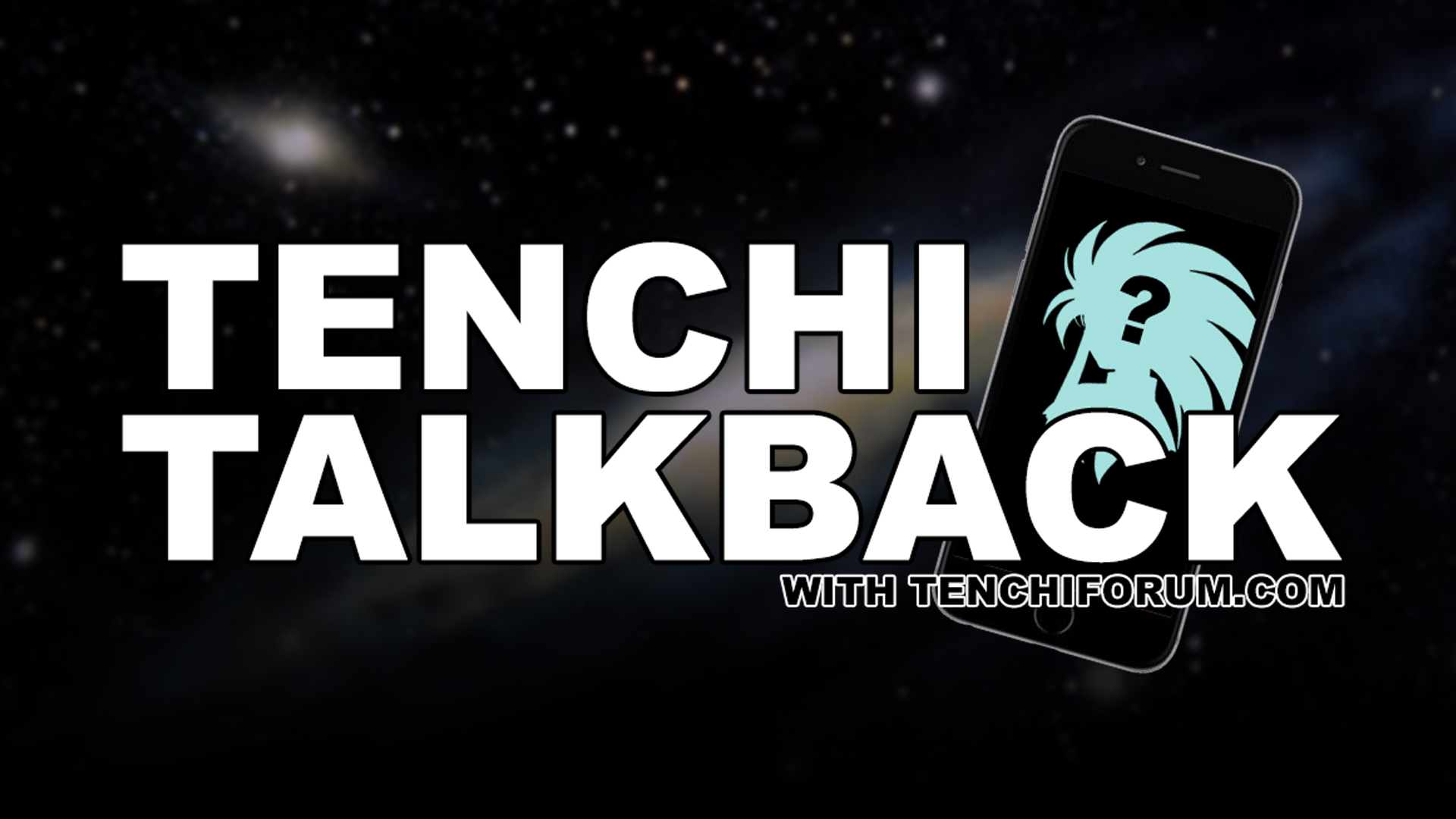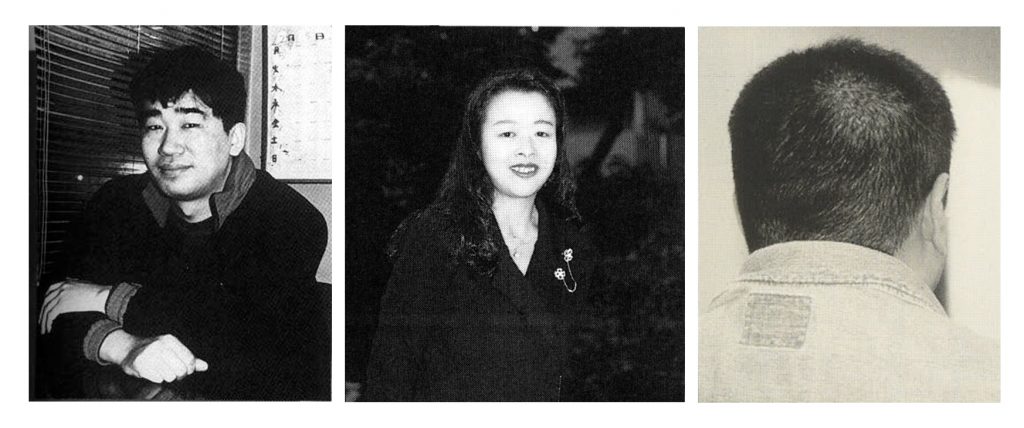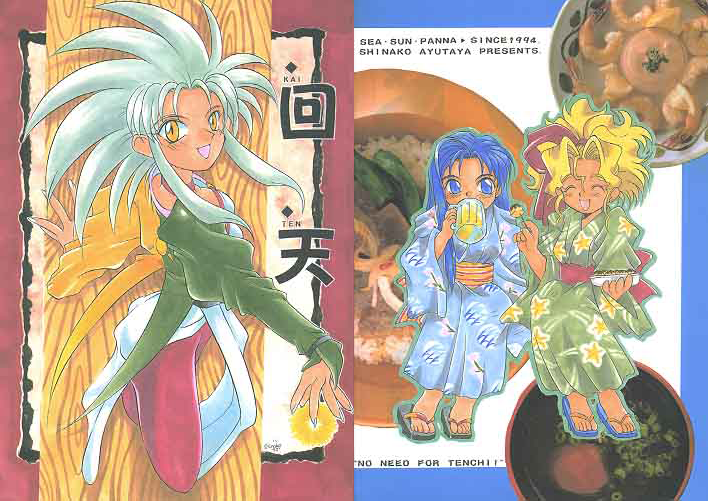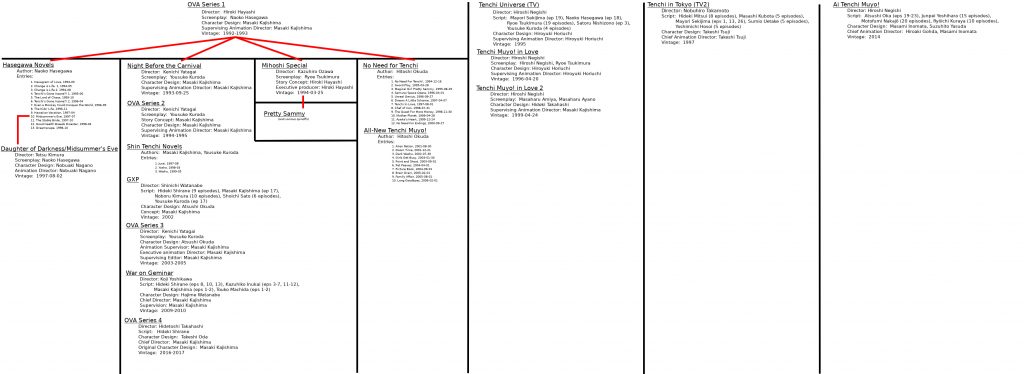
For this installment of Tenchi TalkBack, we are discussing a common question in any large franchise, so buckle up!
HUGE favor. can someone pretty please give me the tenchi muyo timeline pretty please? and also tell me the ones that arnt canon off to the side too pretty please? I want to watch it all. but I want to watch it all in order. pretty please sorry for asking and thank you if someone actually decides to help me.?
Like other large franchises such as Transformers or Teenage Mutant Ninja Turtles, Tenchi Muyo! has had several different incarnations that are loosely connected via shared characters and themes. Particularly during the height of Tenchi’s popularity in the 1990s, the series was reinvented almost annually, and those incarnations had no plot or continuity ties.
Before delving into this quagmire, let me address one particular concept: “canon”. I wrote at length about this matter previously, but I will abridge my thoughts here.
“Canon” comes from the Greek word “κανών”, which translates as “rod” or, more specifically, “measuring rod”. By way of Church Latin, “canon” came to be associated to those scriptures that were held as authoritative and genuine for the faith, those to which all others are compared. Moreover, the religious use is where one derives the antonym “apocrypha”, from the Greek “ἀπόκρυφος”, meaning “hidden” or “obscure”. Not to be confused with “heretical”, a work is apocryphal in a religious context if its authorship or authenticity is questionable. In contrast, a work is heretical in a religious context if it is contrary to church dogma, and the word arises from the Greek “αἵρεσις”, meaning “choice” or “purpose”.
In modern usage, “canon” has two primary definitions, with several other variants depending on discipline:
- the works of an artist that are accepted as authentic;
- a group of works that are generally accepted as representative of a field.
To the matter at hand, entertainment franchises use the word “canon” to segregate works within said franchise. In some cases, defining the canon is fairly simple. For example, if a manga was written by a single author, the canonical entries would be the output of that singular author.
However, the line between canonical and apocryphal becomes blurred when the franchise changes hands, or if the work was not written by one person. As discussed in the previous TalkBack question, Tenchi Muyo! Ryo-Ohki began as a six-episode OVA directed by Hiroki Hayashi, written by Naoko Hasegawa, and with character designs by Masaki Kajishima. Much like with Yuri on Ice, all of these people can be considered creators, though Hayashi and Kajishima are credited the most as they originally conceived of Tenchi during their days working on Bubblegum Crisis.

Some time after the end of the first OVA, Hayashi and Kajishima parted ways, an event which Hayashi discussed in a 2001 interview with AIC. Also, Hasegawa went in her own direction, though she did attempt to adhere to the original concepts of Hayashi and Kajishima as attested by the afterword of her first novel. Consequently, the canon of Tenchi becomes very fractured after the sixth episode, if not outright irrelevant.
The first major continuity, and most complex of all, would be the OVA itself. The first OVA series is six episodes in length, ending with the episode “We Need Tenchi”, which was released on March 25, 1993. The first continuation was by screenwriter Naoko Hasegawa in the first official Tenchi novel, Tenchi Muyo! Ryo-Ohki – Hexagram of Love, released in May 1993, which introduced fan favorite Kiyone Makibi and named Tenchi’s mother “Achika”. Hasegawa would write 13 novels in total from 1993 until 1998, and the 10th novel, entitled Midsummer’s Eve, was adapted into the film Daughter of Darkness released on August 2, 1997. Sadly, much of her body of work does not have an official English translation.
However, Masaki Kajishima has his own variation of the OVA story, branching from the end of “We Need Tenchi”. The OVA special “Night Before the Carnival” was released on September 25, 1993, and continued in its own direction, largely ignoring Hasegawa’s parallel work. Along with coauthor Yousuke Kuroda, Kajishima’s particular brand of Tenchi encompasses several ancillary media, including multiple OVA series (OVA2-4, War on Geminar), light novels (Shin Tenchi), a TV series (GXP), and his own unlicensed, unofficial, self-published comics (i.e. doujinshi).

On March 25, 1994, there was another OVA special entitled Galaxy Police Mihoshi’s Space Adventure, lovingly called the “Mihoshi Special”. Original director Hiroki Hayashi had a hand in this cute little story, alongside scribe Ryoe Tsukimura, who would later write most of the episodes for Tenchi Universe and Tenchi Muyo! in Love. This special has the honor of being the first animated appearance of Kiyone Makibi and also serves as a gateway into the Pretty Sammy franchise, which Hayashi also conceived.
Moreover, the production company AIC handed the reins of Tenchi to other creators, who re-imagined the scenario and characters in their own ways. Some stayed fairly close to the original six-episode OVA, while others took their own liberties with the material. Instead of “canon”, I recommend sorting Tenchi by “continuity”. That is, look for how the media align in terms of plot and characterization.
The second very clear delineation of story is Hiroshi Negishi’s TV series, known in the West as Tenchi Universe (dub, sub). This is a contiguous 26-episode TV series, which is a re-imagining of the original 6-episode OVA and includes Kiyone Makibi as a regular character. It is also followed by two feature films directed by Negishi himself: Tenchi Muyo! in Love, focusing on Achika Masaki, and Tenchi Muyo! in Love 2, focusing on the relationship between Tenchi, Ryoko, and Ayeka. This continuity is self-contained and requires no previous knowledge.
This would be a good time to mention the recent gem Ai Tenchi Muyo!, which Negishi returned to direct. Ai is a series of 50 four-minute shorts and was promoted as a “celebration of the franchise” by AIC. While Ai does not have any direct connection to any previous incarnation, it does make numerous callbacks to various aspects of its predecessors. This can be watched after any of the major incarnations
The final major incarnation would be Nobuhiro Takamoto’s TV series, titled Tenchi in Tokyo (dub, sub) outside of Japan. This is a self-contained 26-episode TV series, which deconstructs the Masaki family and examines each character on their own. It is completely separate from Universe or the OVA, though it does start very abruptly, only discussing the character’s first meeting in the seventh episode, “The Day We Met”.
Also, Hitoshi Okuda wrote two runs of manga for Tenchi from 1994 to 2006, also branching from the OVA at “We Need Tenchi”. While he did make reference to the second and third OVA series from Kajishima and Kuroda, Okuda largely wrote his own original stories. However, he did write a Pretty Sammy story and an adaptation of Tenchi Muyo! in Love.
Below is a chart to summarize the isolation and branching of these continuities.

In conclusion, what is the “canon” of Tenchi? Considering the snippets revealed in interviews and the shifting of the production staff, there is no single canon, even for the OVA. Instead, I would say to think not in terms of “canon”, but rather “continuity”. Honestly, no one can tell you how to enjoy Tenchi, so please, enjoy whichever Tenchi you like!
Got a question you want to see answered? Send us a message on social media, discuss on the forum, or email us at contact@tenchiforum.com